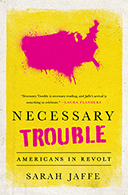Mapping the power behind Trumpism, with Molly Gott
To effectively protest, you have to know who you’re protesting and where the pressure points are. The folks at LittleSis have created a database and research tool that helps organizers figure out who their opponents are, how they’re connected, and where to push in order to get results, and now they’re introducing a project to help bring those research skills to people across the country. Molly Gott of LittleSis tells me all about it.
The first project that we did was on corporate collaborators of Trump in Philadelphia. We went through and looked at “Who are the key donors to Trump in Philly? Who are people that he had created business relationships for? Who are people that were leading business councils or members of business councils that he was appointing?” to really put those folks on display. We released that set of information ahead of May Day when there were some actions happening in Philly, to bring the focus not just on Pat Toomey who is our Republican Senator, but also these corporate villains that are in Philly and didn’t really want to be publicly associated with Trump. That was one thing.
….
Some of my thinking around “What is the role of research in our movements?” came about because I was involved in building some of the jail support apparatus in Ferguson and seeing the ways that actually attracted and gave roles in that movement to folks who maybe couldn’t do other things and gave them a home to be doing political work. So, I was thinking about the way that research can do that, as well. We have been pushing folks, which has been really fun to be doing research in community more. In Philly, we had research pizza nights where we all just bring our computers and do a bunch of tasks really quickly. It is way more fun than just being by yourself behind a computer screen, for sure.
Up at Truthout.
Up at The Baffler.
Interviews for Resistance is a syndicated series of interviews with organizers, agitators and troublemakers, available twice weekly as text and podcast. You can now subscribe on iTunes! Previous interviews here.





